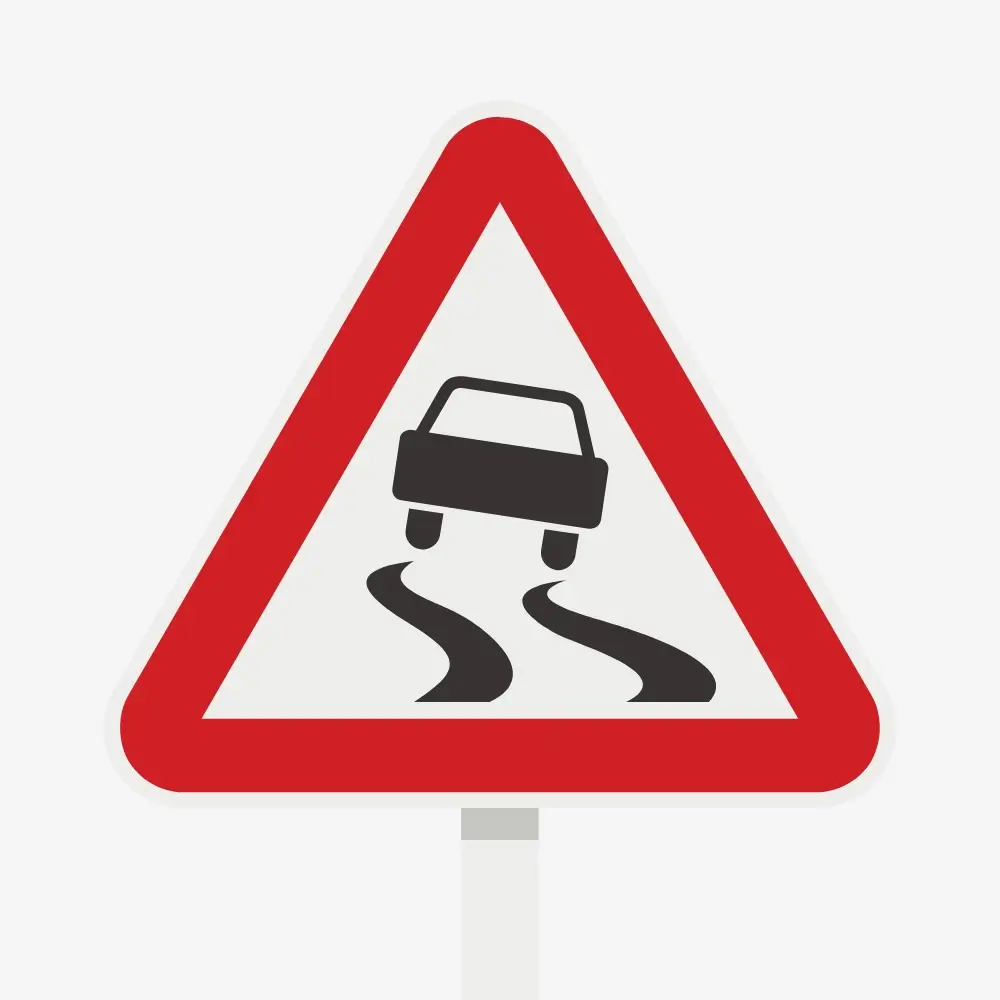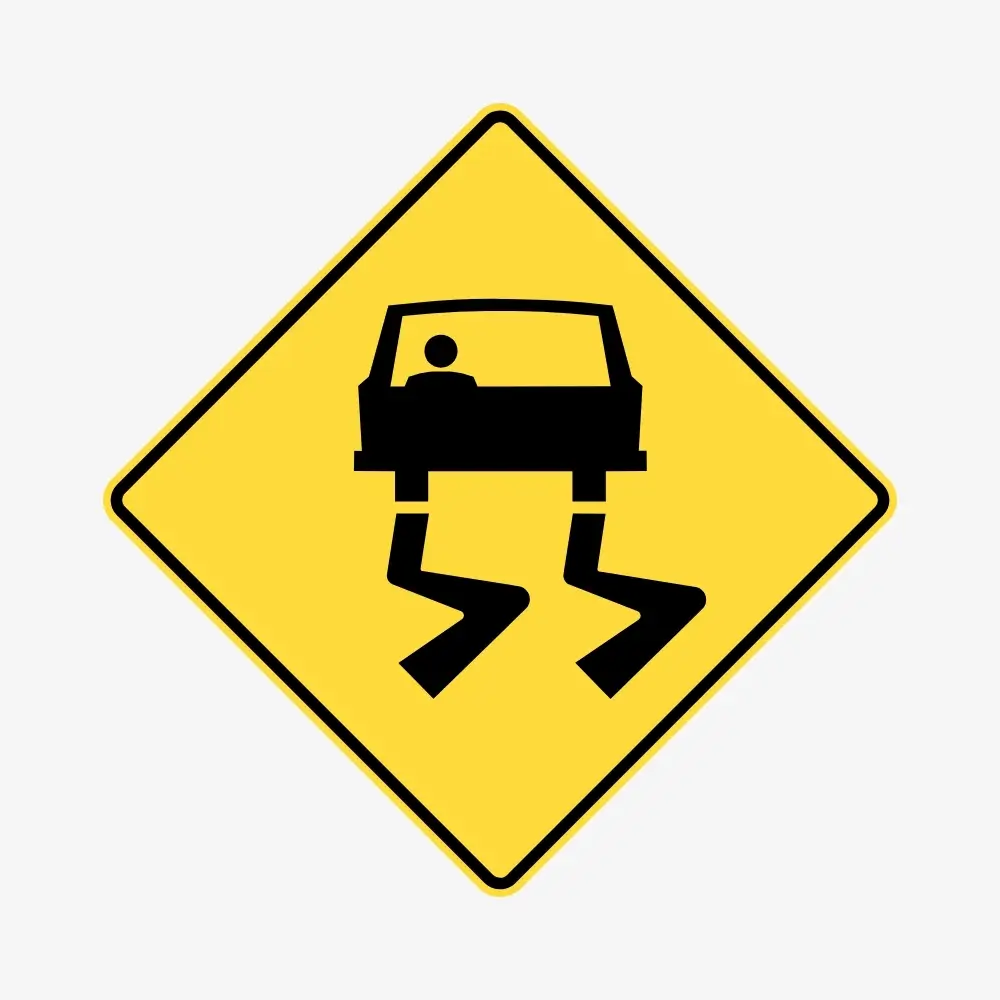Have you ever noticed the “Slippery When Wet” road sign while driving and wondered what it really means? This cautionary road sign plays a crucial role in traffic safety, alerting drivers to potential hazards caused by wet or slick road conditions. Understanding its significance can help prevent accidents, especially during rainy or icy weather.
This article’ll explore the meaning of the “Slippery When Wet” road sign, why it’s important, and what drivers should do when encountering it. We’ll also discuss the science behind slippery roads and how weather conditions impact road grip.
What Does the ‘Slippery When Wet’ Sign Mean?
The “Slippery When Wet” sign is a warning road sign that alerts drivers that the roadway ahead may become hazardous when wet due to rain, ice, or other moisture-related conditions. The sign typically features a black car with wavy skid marks behind it on a yellow background, emphasizing caution.
Key Characteristics of the Sign:
- Shape & Color: Diamond-shaped with a yellow background and black symbols or text.
- Message: Indicates potential slippery conditions when roads are wet.
- Placement: Often found on bridges, curves, steep grades, or areas prone to water accumulation.

Why is the ‘Slippery When Wet’ Sign Important?
The “Slippery When Wet” road sign plays a vital role in traffic safety by alerting drivers to potential hazards caused by wet or slick road conditions. Here are the key reasons why this sign is important:
1. Prevents Skidding and Accidents
When roads become wet due to rain, snow, or ice, tire traction decreases, making vehicles more prone to skidding. This sign warns drivers to slow down and take precautions to avoid losing vehicle control.
2. Alerts to High-Risk Areas
The sign is typically placed in locations known for slippery conditions, such as:
- Bridges & Overpasses – These freeze faster than regular roads, creating unexpected icy patches.
- Sharp Turns & Curves – Wet conditions make it easier for vehicles to slide off the road.
- Steep Hills – Slippery roads make it harder to stop when driving downhill.
- Areas Prone to Oil or Debris – Rainwater mixes with oil and grease on the road, making the surface extra slick.
By placing the sign in these areas, drivers can be prepared and adjust their driving accordingly.
3. Encourages Defensive Driving
The sign serves as a reminder to practice safe driving habits, such as:
- Reducing speed when approaching wet roads
- Avoiding sudden braking or acceleration
- Maintaining a safe distance from other vehicles
- Steering smoothly to prevent skidding
Being aware of potential dangers helps drivers react in time and reduces the likelihood of crashes.
4. Reduces Hydroplaning Risks
Hydroplaning happens when a layer of water builds between the tires and the road, causing the vehicle to lose traction. This warning sign reminds drivers to:
- Drive at a controlled speed to maintain tire grip
- Avoid deep puddles that increase hydroplaning risk
- Check their tire condition for proper tread and inflation
5. Enhances Overall Road Safety
The “Slippery When Wet” sign is part of a broader effort to improve traffic safety. When drivers take note of these warnings, they help prevent:
- Rear-end collisions due to increased stopping distances
- Lane departures caused by loss of control
- Accidents involving motorcycles, trucks, and other vehicles more vulnerable to slippery conditions
The “Slippery When Wet” sign is crucial because it prevents accidents, alerts drivers to high-risk areas, encourages defensive driving, and reduces skidding and hydroplaning risks. When drivers heed this warning, they help protect themselves and others on the road, making travel safer for everyone.

Where is the ‘Slippery When Wet’ Sign Commonly Found?
The “Slippery When Wet” road sign is strategically placed in locations where roads are prone to becoming hazardous when wet. These areas typically have a higher risk of reduced traction, skidding, or hydroplaning due to environmental or roadway conditions.
1. Bridges and Overpasses
- Why? Bridges and overpasses tend to freeze faster than regular roads because they lack ground insulation. This makes them prone to black ice formation in cold weather, creating extremely slippery conditions.
- Common Example: Highways with elevated bridges or freeway overpasses often post this sign before the structure.
2. Sharp Turns and Curves
- Why? Wet surfaces make it harder for vehicles to maintain grip when navigating curves at high speeds. The risk of skidding or spinning out increases in these areas.
- Common Example: Mountain roads, rural highways, and winding roads in hilly areas frequently display this sign before a sharp turn.
3. Steep Inclines and Declines
- Why? When roads are wet, braking on an incline or decline becomes more difficult, increasing the chances of losing control or sliding downhill.
- Common Example: Hilly roads, mountainous terrains, and streets with steep gradients often have this warning.
4. Intersections and High-Traffic Areas
- Why? Intersections and congested areas often have a buildup of oil, grease, and rubber residue from vehicles. When rainwater mixes with these substances, the road becomes dangerously slick.
- Common Example: Busy city intersections, roundabouts, and heavily trafficked roadways may display this sign to warn drivers of reduced traction.
5. Near Water Drainage Areas and Low-Lying Roads
- Why? Roads with poor drainage can accumulate standing water, increasing the risk of hydroplaning—where tires lose contact with the road due to excess water.
- Common Examples: This sign is often found in areas with frequent flooding, roads near lakes or rivers, and streets with inadequate storm drains.
6. Industrial and Construction Zones
- Why? Some roads near factories or construction sites may accumulate oil spills, loose gravel, or mud, which become more hazardous when wet.
- Common Example: Roads near warehouses, loading docks, or construction zones often have this warning to alert drivers of potential slip hazards.
7. Areas Prone to Snow and Ice Formation
- Why? In colder climates, roads can become slick due to snow, slush, or freezing rain, making driving conditions extremely dangerous.
- Common Example: High-altitude highways, northern regions with heavy snowfall, and roads near ski resorts often have permanent ‘Slippery When Wet’ signs as a seasonal precaution.
The “Slippery When Wet” sign is typically found in areas where wet conditions significantly increase the risk of accidents. Whether on bridges, sharp turns, steep inclines, or high-traffic zones, the sign serves as an important safety reminder for drivers to reduce speed, maintain control, and drive cautiously in wet weather.

What Causes Roads to Become Slippery When Wet?
When roads get wet, they become more dangerous and slippery due to several natural and environmental factors. Understanding these causes helps drivers take necessary precautions to avoid accidents. Here are the primary reasons why roads become slippery when wet:
1. Hydroplaning Effect
When water builds up on the road faster than tires can push it away, the vehicle loses direct contact with the road surface and begins to glide over a thin layer of water.
Why is it Dangerous?
- Reduces steering and braking ability.
- Increases stopping distances.
- Can cause a complete loss of control if the driver reacts improperly.
Prevention: Drive at lower speeds, avoid deep water puddles, and ensure tires have good tread depth to channel water away.
2. Oil and Grease Build-Up on Roads
Over time, vehicles leave behind oil, grease, and fuel residues on roads. When rain first begins, these substances mix with water and create an extremely slick surface before being washed away.
Why is it Dangerous?
- The road becomes slippery, especially in the first 10–30 minutes of light rain.
- Sudden braking or accelerating can cause vehicles to skid.
Prevention: Be extra cautious during the first few minutes of rainfall and avoid sudden maneuvers.
3. Ice and Snow Residue
In cold weather, rain can freeze into black ice, an invisible and ultra-slippery layer of ice that coats the road. Even a thin layer of snow mixed with water can cause dangerous conditions.
Why is it Dangerous?
- Black ice is nearly invisible, making it hard to detect.
- Vehicles can slide uncontrollably, even at slow speeds.
Prevention: Drive cautiously on bridges, overpasses, and shaded areas where ice forms first.
4. Smooth Road Surfaces and Worn Pavement
Roads made of smooth asphalt or concrete, especially when worn down over time, lack proper grip when wet.
Why is it Dangerous?
- Increases the risk of hydroplaning.
- Reduces tire traction, making it harder to stop quickly.
Prevention: Drive slower on smoother roads and be mindful of areas where the pavement is worn down.
5. Wet Leaves and Debris on the Road
When wet, leaves, mud, and other debris create a slippery layer similar to ice. This is especially common in autumn when fallen leaves pile up on roads.
Why is it Dangerous?
- Wet leaves reduce tire grip and increase braking distance.
- Patches of mud or debris can cause cars to skid unexpectedly.
Prevention: Avoid driving over large patches of wet leaves or mud, and be cautious after storms.
6. Painted Road Markings and Metal Surfaces
Painted lane markings, crosswalks, and metal surfaces like bridge grates or manhole covers become extra slippery when wet.
Why is it Dangerous?
- Reduced traction, especially for motorcycles and bicycles.
- Increases the likelihood of skidding when turning or stopping.
Prevention: Avoid hard braking on painted lines or metal surfaces, and take turns slowly.
7. Rubber Residue from Tires
Tire wear leaves behind small rubber particles on the road, which can mix with rainwater to create a slick, slippery surface.
Why is it Dangerous?
- Reduces traction, making stopping more difficult.
- More prominent in high-traffic areas like intersections and curves.
Prevention: Keep a safe following distance and avoid sudden maneuvers in high-traffic zones.
Roads become slippery when wet due to hydroplaning, oil build-up, ice, smooth surfaces, wet leaves, and road debris. Understanding these factors allows drivers to adjust their driving habits, reduce speed, and stay alert to minimize risks. Next time you see a “Slippery When Wet” sign, take extra caution—it’s there for a reason! 🚗💨

How to Drive Safely When You See a ‘Slippery When Wet’ Sign
When you encounter a “Slippery When Wet” sign, it’s a warning that the road ahead can become hazardous in wet or icy conditions. To avoid accidents and maintain control of your vehicle, follow these safe driving tips:
1. Reduce Your Speed
Wet roads decrease traction, making it harder to stop or turn quickly.
What to Do:
- Slow down gradually before reaching the slippery area.
- Drive at a safe speed lower than the posted limit if conditions are wet.
Tip: On wet roads, reduce your speed by at least 5-10 mph to improve control.
2. Increase Your Following Distance
Wet roads increase stopping distances because tires don’t grip as well.
What to Do:
- Maintain a 4-6 second following distance instead of the usual 3 seconds.
- Give yourself more time to react in case the vehicle ahead suddenly slows down.
Tip: The more water on the road, the longer your stopping distance should be.
3. Avoid Sudden Braking and Acceleration
Slamming on the brakes or accelerating too quickly can cause skidding.
What to Do:
- Brake gently to prevent losing control.
- Accelerate smoothly to avoid tire spin.
- If your car has anti-lock brakes (ABS), apply steady pressure rather than pumping the brakes.
Tip: If you start to skid, steer in the direction of the skid and avoid overcorrecting.
4. Be Cautious on Bridges and Overpasses
These surfaces freeze faster and can develop black ice, even if other roads seem clear.
What to Do:
- Slow down before reaching a bridge or overpass.
- Avoid sudden steering or braking while on these structures.
Tip: Assume that any wet-looking bridge surface in cold weather may have ice.
5. Watch for Puddles and Standing Water
Driving through deep water increases the risk of hydroplaning (when tires lose grip and slide uncontrollably).
What to Do:
- Avoid puddles if possible.
- If you must drive through water, do so slowly and steadily without sudden movements.
- If hydroplaning occurs, ease off the gas and steer gently in the direction you want to go—don’t slam the brakes!
Tip: If your steering feels light or unresponsive, your tires may be hydroplaning—slow down immediately.
6. Use Your Headlights in Rainy or Foggy Conditions
Low visibility makes it harder to see hazards ahead.
What to Do:
- Turn on low-beam headlights in rain or fog.
- Avoid using high beams, as they reflect off moisture and reduce visibility.
Tip: If visibility is severely reduced, pull over safely and wait for conditions to improve.
7. Check Your Tires for Proper Traction
Worn-out tires lose grip faster on wet roads.
What to Do:
- Ensure your tire tread depth is at least 2/32 of an inch (use the penny test—if Lincoln’s head is visible, replace your tires!).
- Keep tires properly inflated for better traction.
Tip: Underinflated or bald tires significantly increase skidding risks on wet roads.
8. Be Extra Careful on Curves and Turns
Taking a turn too fast can cause loss of control on slippery roads.
What to Do:
- Slow down before entering a curve.
- Avoid hard braking or sharp turns while in the curve.
Tip: If your car starts sliding on a curve, steer in the direction of the skid and ease off the accelerator.
9. Stay Alert for Other Drivers
Not all drivers adjust their speed in wet conditions, increasing the risk of accidents.
What to Do:
- Be prepared for sudden stops from other vehicles.
- Keep an eye on large trucks and motorcycles, as they may have more difficulty in wet conditions.
Tip: Defensive driving can help you avoid reckless drivers who fail to adjust to slippery roads.
10. Know When to Pull Over and Wait
Sometimes, weather conditions are too dangerous to continue driving.
What to Do:
- If rain is heavy or roads are icy, pull over to a safe location and wait until conditions improve.
- Avoid stopping on shoulders or highways—instead, find a parking lot or rest stop.
Tip: If visibility is too poor to see the road ahead, it’s safer to stop than to risk driving blind.
When you see a “Slippery When Wet” sign, it’s a clear warning to drive cautiously. By reducing speed, avoiding sudden maneuvers, increasing your following distance, and staying alert, you can greatly reduce the risk of skidding or accidents on wet roads.
FAQs About the ‘Slippery When Wet’ Sign
Conclusion
The ‘Slippery When Wet’ road sign is a crucial warning for drivers to exercise caution when roads are wet or icy. Understanding the risks associated with slippery roads and following safe driving practices can help prevent accidents and ensure a smooth journey.
Next time you see this sign, slow down, drive carefully, and stay alert to changing road conditions. Being prepared could be the key to avoiding a dangerous situation on the road.
Did you find this guide helpful? Bookmark this page and share it with others to promote road safety awareness! 🚗💨














